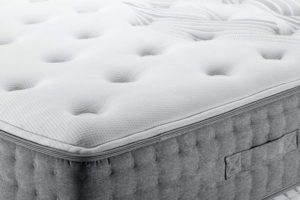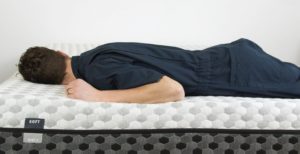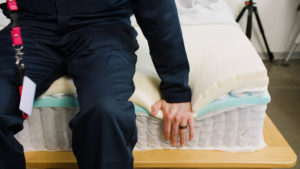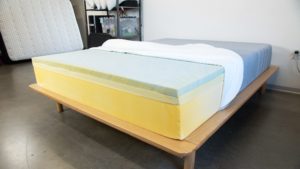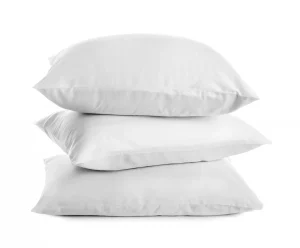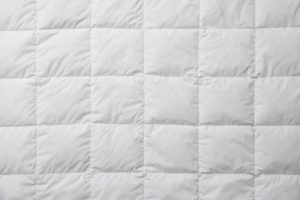Body Weight
A big part of our mission at SleepFoundation.org is to help you find the best mattress to improve your sleep quality. While mattress comfort often comes down to personal preferences, body weight can have a major impact on how a bed feels.
Your body weight determines how much pressure you place on a mattress. In turn, this impacts the bed’s comfort. For example, while a firm mattress may lack cushioning for a lighter sleeper, that bed may strike the perfect balance between pressure relief and support for a heavier individual.
Our Test Lab, located in Seattle, provides data-backed recommendations that can lead to your best night’s sleep. To account for the influence of body weight, we employ sleep testers of different weights, ranging from less than 130 pounds to over 230 pounds. This ensures that all of our performance tests and ratings address the needs of sleepers of varying sizes.
To give you a better idea of how body weight affects mattress performance and comfort, we’ll discuss this factor in detail and explain how it fits into our mattress testing protocols.
Our Body Weight System
When shopping for a new mattress, it’s important to consider how much you weigh. The same mattress generally feels softer to a heavier person than it does to a lighter individual due to the amount of force on the surface. We’ve found that sleepers with similar body weights tend to have similar comfort preferences. That’s why we use weight groups to establish the suitability of certain mattress models for sleepers of different body types.
Keep in mind that body weight is only one piece of the puzzle. You should also consider the interplay between your weight and preferred sleep position. Like body weight, your position determines how much pressure you place on your mattress and influences comfort.
Body Weight Categories
We use three weight categories to rate how a mattress may perform for sleepers with similar body types.
| Under 130 lbs. | 130-230 lbs. | Above 230 lbs. |
|---|---|---|
| Sleepers who weigh under 130 pounds don’t place much pressure on their mattresses. An individual in this category is likely to find a softer model more comfortable because it allows them to sink in a bit for greater cushioning and pressure relief. | Sleepers who weigh between 130 and 230 pounds place a moderate amount of pressure on their sleep surface. A medium to medium firm mattress usually meets the needs of most people in this category. | Sleepers who weigh over 230 pounds place more pressure on their mattresses, resulting in greater potential for sinkage. Therefore, most individuals in this category need a slightly firmer mattress to provide added support and prevent them from sinking into the bed’s support core. |
Body Weight and Sleeping Position
Body weight represents an important consideration for mattress comfort, and your position impacts your weight distribution across the sleep surface. To find a bed that’s right for you, take into account your favorite sleep position as well as your body weight.
For example, people who weigh over 230 pounds tend to sink more deeply into a sleep surface. However, the degree of sinkage depends in part on whether you sleep on your back, stomach, or side. In general, side sleeping concentrates the vast majority of your body weight onto one hip and shoulder, creating more prominent pressure points. However, stomach sleepers usually apply more force to the center of the bed, which can lead to sagging that jeopardizes spinal alignment.
Mattress Materials and Body Weight
A bed’s construction can dramatically influence its performance for sleepers in different weight ranges. This is especially true of the bed’s comfort system, which generally has the greatest impact on the overall feel. We’ll cover the most common types of mattress materials and how body weight can affect their performance.
| Memory Foam | Memory foam is a specially formulated type of polyurethane foam. Tempur-Pedic popularized the use of memory foam in mattresses, and the material is now a mainstay in the industry. It is common in comfort and transition layers. | Memory foam molds to the shape of the sleeper’s body, providing excellent pressure relief. However, its close hug can trap heat and make changing positions more difficult. | With the right firmness level, memory foam can cradle the body and evenly distribute weight. However, softer options could allow excessive sinkage for sleepers who weigh over 230 pounds, while firmer options may fail to provide optimal pressure relief for sleepers under 130 pounds. |
| Polyfoam | This is a broad category that includes any material made from polyurethane foam. Polyfoam is traditionally used for the support core of all-foam models. Comfort or transition layers of all-foam or hybrid mattresses also frequently incorporate the material. | Polyfoam tends to be springier and less contouring than memory foam. This generally makes polyfoam more breathable and easier to move on, but it may limit pressure relief. | Because polyfoam comes in a wide range of firmnesses, this material is suitable for all weight groups. However, shoppers should look for a firmness level that corresponds to their body weight to balance comfort and support. |
| Latex | Usually derived from the sap of rubber trees, latex is a durable and responsive material. Although synthetic latex exists, most mattress manufacturers use natural latex. Both the support core and the comfort layers of a model can use latex. | Latex is typically bouncier than memory foam or polyfoam. The material also spreads the sleeper’s weight over a wider area, thereby limiting sinkage. However, it still provides moderate contouring and pressure relief. | With its responsive support, latex can be a good choice for sleepers in every weight group. Individuals who weigh more than 230 pounds may benefit from the material’s lack of hug, while sleepers under 130 pounds may enjoy the gentle cradling of softer formulations. |
| Microcoils | Microcoils are small, pocketed coils in the comfort system or transitional layer of some hybrid models. Unlike the taller springs in support cores, microcoils are typically just 1 to 3 inches thick. | A layer of microcoils often improves the breathability, responsiveness, and support of a mattress. Microcoils can also provide pressure relief but are generally more durable and resistant to sagging than most memory foam or polyfoam. | Depending on their thickness and gauge, microcoils can provide comfort and support for sleepers in any weight category. |
Body Weight and Mattress Type
Mattress manufacturers combine materials in various configurations to create different mattress types. The most common types of mattresses include innerspring, hybrid, all-foam, latex, and airbed mattresses.
The defining feature of each mattress type is the support core, which is the thick, lower layer of the bed. This component helps support your body weight and prevent you from sagging too deeply into the mattress.
There isn’t one type of mattress that’s consistently best for certain weight groups or sleep positions, but the support core carries distinct implications for the overall performance.
Innerspring: An innerspring mattress consists primarily of coils, though it may also include minimal padding on the surface. Depending on the variety of springs and their gauge, an innerspring model may be appropriate for any weight group. However, this type of mattress is often especially popular with sleepers who weigh more than 230 pounds. Firmer innerspring models tend to resist sagging while providing enough edge support to allow heavier individuals to use the full sleep surface.
Hybrid: Hybrid mattresses traditionally combine a pocketed coil support core with a substantial comfort system made of memory foam, polyfoam, latex, or microcoils. Since hybrid comfort systems vary widely in their construction and firmness, this category is quite diverse in terms of feel.
Plusher models can cushion lighter individuals, while firmer options often provide enough support and stability for sleepers who weigh over 230 pounds. Because of their thick comfort systems, hybrids are often ideal for side sleepers who need extra pressure relief without sacrificing support. Those on the higher end of the weight range may also appreciate models with reinforced perimeters for enhanced edge support.
All-Foam: An all-foam mattress includes foam in both its support core and comfort system. The comfort system may consist of memory foam, polyfoam, or latex, while the support core uses high-density polyfoam.
All-foam models usually excel in contouring and motion isolation. Because of this contouring, some models may not provide enough support for sleepers who weigh over 230 pounds. However, options specifically designed to support larger bodies should cradle the sleeper without compressing excessively.
Latex: Latex mattresses contain natural, synthetic, or blended latex in their comfort systems and support cores. The comfort system may use light, airy Talalay latex or denser, more durable Dunlop latex, while the core is almost always Dunlop latex.
Depending on their firmness and construction, models made of latex may be appropriate for any weight group. Individuals who weigh less than 130 pounds may prefer models with softer Talalay latex comfort layers, and sleepers over 230 pounds may benefit from the support of sturdy Dunlop latex. Regardless of the sleeper’s weight, latex’s low point elasticity makes it distribute compression over a wider area to cradle the body while limiting sinkage.
Airbeds: An airbed contains an air chamber core and usually a comfort system of memory foam, polyfoam, or latex. Since the air chambers can be emptied or filled to adjust the firmness level, airbeds may be a good choice for anyone whose support needs could change over time, including sleepers with fluctuating weights.
Most queen and king size airbeds include at least two air chambers that can be adjusted separately for a different firmness on each side of the bed. This may be ideal for partners with different body types or firmness preferences.
That said, if the airbed has a particularly thin or soft comfort system, heavier individuals could sink through and press against the core.
How Does Body Weight Fit Into Our Testing?
To account for the effects of body weight, we incorporate this factor into nearly all of our mattress testing protocols.
Our testing team includes sleepers in each of the three body weight categories: under 130 pounds, between 130 and 230 pounds, and above 230 pounds. We also have team members with different position preferences. This allows us to gather a fuller picture of how a mattress may perform for a broad spectrum of sleepers.
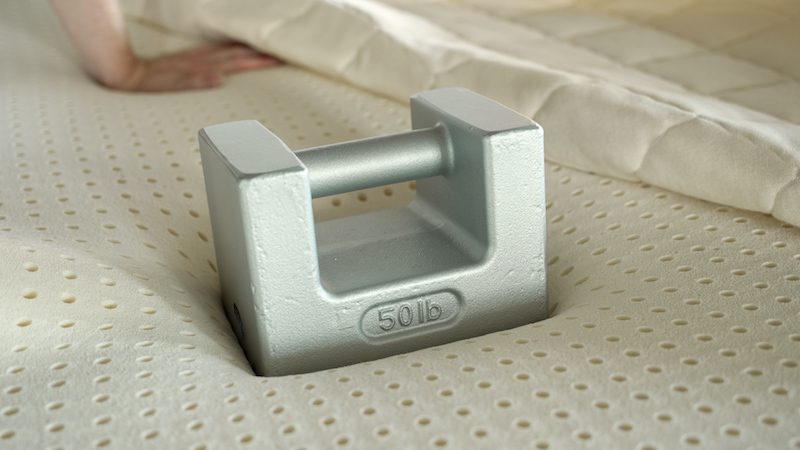
How We Test for Sleep Style and Body Weight
The most obvious area you can see the effect of body weight is in our sleeping style and body weight ratings. In each of our mattress guides, we rate mattresses based on both sleep position and body weight.


For this comfort test, we have sleep testers from each weight category try a mattress in each sleep position: back, side, and stomach. Each tester records their experiences from the viewpoint of a potential sleeper. They take detailed notes about their impressions in terms of comfort and feel.
This is a fairly qualitative test. However, it gives our research team a better understanding of whether a bed can meet the unique needs of many types of sleepers. For example, a side sleeper who weighs between 130 and 230 pounds likely has different needs and preferences than a back sleeper who weighs under 130 pounds.
Performance Ratings for Sleeping Style and Body Weight
Our sleeping style and body weight analyses examine how the mattress performs for individuals of different body types when lying on their sides, backs, and stomachs. Ratings reflect the qualitative comfort level of our testing team. Each review includes an easy-to-read table that highlights these ratings, similar to the following:
| Side Sleepers | Fair | Fair | Good |
| Back Sleepers | Good | Excellent | Good |
| Stomach Sleepers | Good | Excellent | Good |
Body Weight and Other Performance Ratings
Body weight also plays a major role in many of our other performance metrics, including:
We don’t include a specific breakdown for body weight within these categories, but sleep testers from each weight group participate in every performance test. Their diverse feedback informs our final ratings.
Learn more about the Test Lab at the link below.

Frequently Asked Questions About Body Weight and Mattresses
What type of mattress is best for lighter sleepers?
Lighter individuals tend to feel most comfortable on a relatively soft mattress with ample contouring. A firmer sleep surface may not let them sink in much, which can contribute to pressure buildup.
If you weigh less than 130 pounds, consider a soft (3), medium soft (4), or medium (5) model. Side sleepers may prefer an option on the softer end of this range, while stomach sleepers often benefit from a firmer model.
With the right firmness level and contouring, all-foam, hybrid, latex, airbed, or innerspring mattresses could be comfortable for sleepers who weigh less than 130 pounds.
What type of mattress is best for heavier sleepers?
The best mattresses for heavy sleepers tend to be firmer and more supportive. This combination helps promote proper spinal alignment and prevent you from sinking too deeply into the surface of your bed.
If you weigh over 230 pounds, consider a mattress in the medium firm (6) to firm (7-8) range. Side sleepers usually favor the softer end of the spectrum, while stomach sleepers may need the extra support of a firmer model.
Individuals in this weight group should also note that thicker comfort layers can help prevent sinkage against the firm support core. The construction of the core is another important consideration. Certain materials tend to create a more stable surface for heavier sleepers. For example, models with coil cores often provide more substantial support than all-foam options.
Additionally, zoning may also be beneficial. This construction technique incorporates added support in areas where it’s needed most, like the midsection.
How can I make my mattress more comfortable if my weight changes?
Adding a topper or placing your mattress on a sturdier foundation can adjust the feel to better accommodate your changing weight.
If you’ve lost weight and your mattress is now too firm, incorporating a plush topper can add cushioning and cradling. An exceptionally firm topper may also be helpful if you’ve gained weight and your mattress is too soft. Using the mattress with a more stable foundation or a bunkie board can also help firm up the feel and add support, but you should always make sure the base is compatible with your mattress model.



